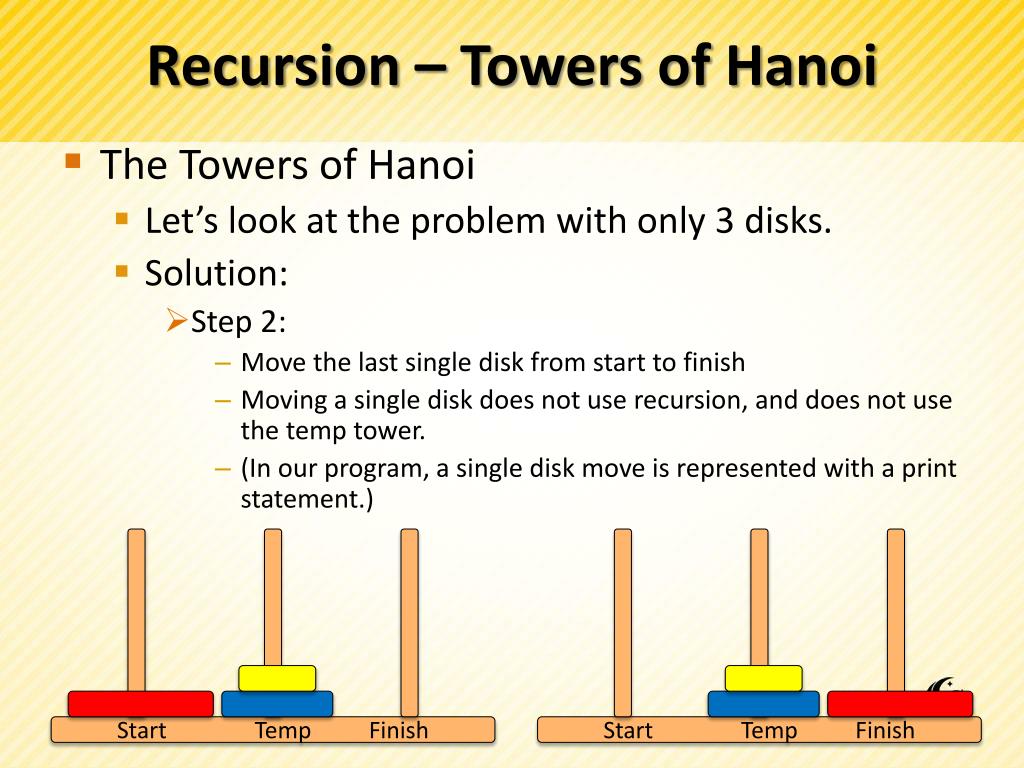

Further Reading:ĪJ’s definitive guide for DS and Algorithms. As in this tutorial we have solved using recursion, we have taken the time complexity of recursion. I have written as “recursion” because, there is a way that you can solve this by using Dynamic Programming and Divide and Conquer Methods. The time complexity of Tower of Hanoi using recursion is 2^n at worst case. Output Move disk 1 from the tower A to tower B Step 2 : Shift second disk from 'A' to 'B'. An example with 3 disks : Step 1 : Shift first disk from 'A' to 'C'. Step 3 : Shift first disk from 'B' to 'C'. Step 2 : Shift second disk from 'A' to 'C'. So knowing the towers involved and whether the disk to be moved is odd or even would allow us to decide which way to move. let A, B, C be the names of the towers. An example with 2 disks : Step 1 : Shift first disk from 'A' to 'B'.
#MOVE METHOD HANOI TOWERS HOW TO#
Tower_of_hanoi(n - 1, temp, destination, source) How to Solve a Seven-Disk Tower of Hanoi Puzzle Step One - Move Disk 1 to the Left Step Two - Move Disk 2 Step Three - Move Disk 1 to the Left Step Four. Tower_of_hanoi(n - 1, source, temp, destination) Ĭout << "Move disk " << n << " from tower " << source << " to tower " << destination << endl The puzzle solution process (game) calls for one-by-one disk moves. Void tower_of_hanoi(int n, char source, char destination, char temp)Ĭout << "Move disk 1 from the tower " << source << " to tower " << destination< i.e for n rings it will take 2^n-1 steps. There are three poles in a row, the one on the left containing a series of discs of decreasing size, with the other two, empty. So from the above diagram, we can see that, to move only 3 rings we took 7 steps. We follow below steps to move all the 3 rings to the 2nd tower. You must move these to another stack (on the right). From every arbitrary distribution of disks, there is exactly one shortest way to move all disks onto one of the three pegs. To illustrate the solution to the problem, consider the below diagram that has 3 rings. In the classic Tower of Hanoi game/puzzle, a stack of disks, sorted by size, appears (on the left). Your goal is to move all the rings from one tower to another tower without breaking the below rules.ģ. There might be “n” number of rings, but there will be only 3 towers. There are different size of rings placed on top of each other in ascending order. Non Iterative tower of Hanoi solution import of Hanoi is a classic problem that can be solved with the help of recursion. How long does your move() method take to compute the sequence of moves to move n disks from one peg to the other The running time of recursive algorithms is. To make it a bit easier to see, here the version which only counts: let rec hanoi1 n p1 p2 p3 acc = Hanoi (n-1) p1 p3 p2 // this is where a move is hanoi (n-1) p2 p1 p3 acc In order to show this in a compact form, here a very short version of towers of hanoi (consider this a rapid prototype for your java program ) It also shows how to use the return value of the function to obtain - here the move list - in your case, your counter. hanoi(3,1,3) > There are 3 disks in total in rod 1 and it has to be shifted from rod 1 to rod 3(the destination rod). This is where you should increase your move counter. Solving the Tower of Hanoi program using recursion: Function hanoi(n,start,end) outputs a sequence of steps to move n disks from the start rod to the end rod. Then you move p1 to p3 and then you move the rest from p2 to p3.įrom this textual description, it is obvious, that you only really make a move in the "move p1 to p3" section. In order to move the bottom most (n'th) disk from p1 to p3, you first need to move the n-1'th disk from p1 to p2 (and cleanup).#MOVE METHOD HANOI TOWERS SERIES#



 0 kommentar(er)
0 kommentar(er)
